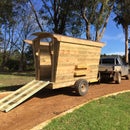Introduction: Giant Trebuchet
Make a giant trebuchet in less than a day with a couple of trees, some rope and a few other easily found parts.
Best made in a paddock with plenty of room for hurling and a tractor with a loader will make it easy to get the throwing arm onto the support frame.
Step 1: Prepare Materials
Actions required for step 1 are:
Select tree
Detatch roots from trunk
Remove branches
We used a couple of blue gums, a fast growing eucalyptus (Eucalyptus globulus) approx 10 years old.
We cut the following:
Main arm 10.5m long
Legs 2 x 3m long
2 x 3.5m long
cross arm (pivot) 2m long
For cross bracing we used 1 by 5m length and 2 x 2.5m lengths.
(multiply by 3 for approx lengths in ft)
(note the chaps, face mask and safety helmet used when felling tree are omitted by model pretending to fell tree)
After cutting timber to length, find a good location for building the treb and set out timbers. Starting with legs, lash the tops of each 3m leg to a 3.5m leg leaving enough overhang at the top for the cross arm (pivot) to sit in. I had some help from my kids who had practised lashing at scouts with this step.
Step 2: Set Up Frame
Stand up the legs and hold in place with temporary bracing while you attach cross braces. We originally put permanent cross braces between the legs as this was easy to do. This was not a good move as you want the arm to swing freely without hitting the cross bracing. Yes seems obvious in hind sight. The mannequin in the second photo is demonstrating where not to stand when there is only temporary bracing in place.
Outrigger style cross bracing is a better solution. Lay a long pole (approx 5m) on the ground in front of the legs and fix to legs by lashing or heavy duty coach bolt. Then lash or bolt cross braces between the pole and the legs.
Step 3: Throwing Arm
Lash a cross brace about 2m from the large (butt) end of the large log chosen for the throwing arm. Rope is fine, but rachet straps make it easy to get nice and tight. There will be a lot of weight on this joint when the arm is vertical - the weight of the arm plus the counterweight, so this joint needs to be good. A chain screwed to the end of the log (butt end) and then back to the cross arm can be used if there is any doubt about a lashed joint.
Lift the arm and set the cross arm in the v at the top of the legs. We used a tractor so this was quick and easy. If you don't have access to a tractor, place the cross arm (which is light enogh to carry up a ladder) in position first and then use a cum along winch or block and tackle to lift the main arm and lash in place.
Screw a coach screw into the end of the throwing arm (long end) at an angle that is slightly above horizontal when the arm is pulled down to the ground. Leave the unthreaded portion of the bolt exposed. Cut the hex end off the bolt, leaving a smooth pin.
At the short (butt) end, drill a hole right through the log, close to the end at right angles to the arm and parallel to the cross arm to suit a long bolt or rod, about 16mm. Insert a rod through this hole to pivot a counterweight from.
Step 4: Counterweight
Attach a counterweight to the pin in the short end of the arm. The weight needs to be in proportion to the weight of the throwing arm and the strength of the structure. We have started with a 20 gallon steel drum, bolted chain to the sides of the drum and then used shackles to attach the chain to the pin. The drum was attached while empty and was then filled with rocks and sand.
Step 5: Throw Something
1. Every good treb needs a name. This was a job for the kids, and they dubbed her "Pain Bringer"
2. Tie a rope to the long end of the throwing arm that you can use to pull the arm back down for firing.
3. Keep people, buildings, cars etc away from the treb, particularly in front and behind. Yes it is possible to fire the projectile backwards
4. Always assume that a rope or a joint will fail. Place yourself and anyone you don't want to send to hospital in a place where they will not be hit if something fails.
What to throw? Plastic bottles filled with water are great, make a nice wet splat. Strictly a single use item. Small heavy thing go further, eg the hammer that we were using for the build.
Update - In the video we are throwing bottles of water 2 - 3 kg about 30m or 90ft. In order to pull the arm back by one person pulling on a rope, we were restricted on the counterweight size we could use. We recently increased the counterweight by only about 25% and saw the throwing distance increase fairly dramatically to 65m or 200ft. Why so much from a small(ish) increase in counterweight size? I think this is because the weight of the arm is also quite heavy and this offsets the counterweight, so increasing the counterweight by a relatively small percentage increases the difference in weight between the throwing arm and the counterweight by a much greater amount.

Participated in the
Redneck Contest













